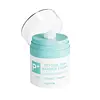What's inside
What's inside
 Key Ingredients
Key Ingredients

 Benefits
Benefits

 Concerns
Concerns

 Ingredients Side-by-side
Ingredients Side-by-side

Water
Skin ConditioningGlycerin
HumectantDipropylene Glycol
HumectantCaprylic/Capric Triglyceride
MaskingButylene Glycol
HumectantCetyl Alcohol
EmollientCetearyl Olivate
Niacinamide
SmoothingCetyl Ethylhexanoate
EmollientButyrospermum Parkii Butter
Skin Conditioning1,2-Hexanediol
Skin ConditioningSorbitan Olivate
EmulsifyingGlyceryl Stearate
EmollientIsononyl Isononanoate
EmollientStearyl Alcohol
EmollientPalmitic Acid
EmollientVinyldimethicone
Polyglyceryl-6 Stearate
EmollientCarbomer
Emulsion StabilisingTromethamine
BufferingMyristyl Alcohol
EmollientDiisostearyl Malate
EmollientHydroxyethyl Acrylate/Sodium Acryloyldimethyl Taurate Copolymer
Emulsion StabilisingBetaine
HumectantXanthan Gum
EmulsifyingPanthenol
Skin ConditioningSqualane
EmollientArgania Spinosa Kernel Oil
EmollientLauryl Alcohol
EmollientEthylhexylglycerin
Skin ConditioningTocopheryl Acetate
AntioxidantPolyglyceryl-6 Behenate
Emulsion StabilisingAdenosine
Skin ConditioningDisodium EDTA
Sorbitan Isostearate
EmulsifyingStearic Acid
CleansingMyristic Acid
CleansingSodium Hyaluronate
HumectantCeramide NP
Skin ConditioningCaprylyl Glycol
EmollientAcetyl Hexapeptide-8
HumectantWater, Glycerin, Dipropylene Glycol, Caprylic/Capric Triglyceride, Butylene Glycol, Cetyl Alcohol, Cetearyl Olivate, Niacinamide, Cetyl Ethylhexanoate, Butyrospermum Parkii Butter, 1,2-Hexanediol, Sorbitan Olivate, Glyceryl Stearate, Isononyl Isononanoate, Stearyl Alcohol, Palmitic Acid, Vinyldimethicone, Polyglyceryl-6 Stearate, Carbomer, Tromethamine, Myristyl Alcohol, Diisostearyl Malate, Hydroxyethyl Acrylate/Sodium Acryloyldimethyl Taurate Copolymer, Betaine, Xanthan Gum, Panthenol, Squalane, Argania Spinosa Kernel Oil, Lauryl Alcohol, Ethylhexylglycerin, Tocopheryl Acetate, Polyglyceryl-6 Behenate, Adenosine, Disodium EDTA, Sorbitan Isostearate, Stearic Acid, Myristic Acid, Sodium Hyaluronate, Ceramide NP, Caprylyl Glycol, Acetyl Hexapeptide-8
Water
Skin ConditioningButylene Glycol
HumectantGlycerin
HumectantHydrogenated Polyisobutene
EmollientC15-19 Alkane
SolventAluminum Starch Octenylsuccinate
AbsorbentPolyacrylamide
Phenoxyethanol
PreservativeHydrogenated Poly(C6-14 Olefin)
EmollientC13-14 Isoparaffin
EmollientIsomalt
HumectantCaprylyl Glycol
EmollientCarbomer
Emulsion StabilisingSodium Hydroxide
BufferingSodium Hyaluronate
HumectantLaureth-7
EmulsifyingDisodium EDTA
Tocopheryl Acetate
AntioxidantNymphaea Alba Flower Extract
Skin ConditioningLecithin
EmollientLauroyl Lysine
Skin Conditioning1,2-Hexanediol
Skin ConditioningAcetyl Glutamine
Skin ConditioningBacillus/Folic Acid Ferment Filtrate Extract
AntioxidantSh-Oligopeptide-1
Skin ConditioningSh-Oligopeptide-2
Skin ConditioningSh-Polypeptide-1
Skin ConditioningSh-Polypeptide-11
Sh-Polypeptide-9
Skin ConditioningSymphytum Officinale Callus Culture Extract
Skin ConditioningSodium Benzoate
MaskingLactic Acid/Glycolic Acid Copolymer
Skin ConditioningPolyvinyl Alcohol
Copper Palmitoyl Heptapeptide-14
Skin ConditioningHeptapeptide-15 Palmitate
Skin ConditioningWater, Butylene Glycol, Glycerin, Hydrogenated Polyisobutene, C15-19 Alkane, Aluminum Starch Octenylsuccinate, Polyacrylamide, Phenoxyethanol, Hydrogenated Poly(C6-14 Olefin), C13-14 Isoparaffin, Isomalt, Caprylyl Glycol, Carbomer, Sodium Hydroxide, Sodium Hyaluronate, Laureth-7, Disodium EDTA, Tocopheryl Acetate, Nymphaea Alba Flower Extract, Lecithin, Lauroyl Lysine, 1,2-Hexanediol, Acetyl Glutamine, Bacillus/Folic Acid Ferment Filtrate Extract, Sh-Oligopeptide-1, Sh-Oligopeptide-2, Sh-Polypeptide-1, Sh-Polypeptide-11, Sh-Polypeptide-9, Symphytum Officinale Callus Culture Extract, Sodium Benzoate, Lactic Acid/Glycolic Acid Copolymer, Polyvinyl Alcohol, Copper Palmitoyl Heptapeptide-14, Heptapeptide-15 Palmitate
 Reviews
Reviews

Ingredients Explained
These ingredients are found in both products.
Ingredients higher up in an ingredient list are typically present in a larger amount.
1,2-Hexanediol is a synthetic liquid and another multi-functional powerhouse.
It is a:
- Humectant, drawing moisture into the skin
- Emollient, helping to soften skin
- Solvent, dispersing and stabilizing formulas
- Preservative booster, enhancing the antimicrobial activity of other preservatives
Butylene Glycol (or BG) is used within cosmetic products for a few different reasons:
Overall, Butylene Glycol is a safe and well-rounded ingredient that works well with other ingredients.
Though this ingredient works well with most skin types, some people with sensitive skin may experience a reaction such as allergic rashes, closed comedones, or itchiness.
Learn more about Butylene GlycolCaprylyl Glycol is a humectant and emollient, meaning it attracts and preserves moisture.
It is a common ingredient in many products, especially those designed to hydrate skin. The primary benefits are retaining moisture, skin softening, and promoting a healthy skin barrier.
Though Caprylyl Glycol is an alcohol derived from fatty acids, it is not the kind that can dry out skin.
This ingredient is also used as a preservative to extend the life of products. It has slight antimicrobial properties.
Learn more about Caprylyl GlycolCarbomer is a polymer of acrylic acid. Its main role is to create a gel consistency.
A high amount of carbomer can cause pilling or balling up of products. Don't worry, most products contain 1% or less of carbomer.
Disodium EDTA plays a role in making products more stable by aiding other preservatives.
It is a chelating agent, meaning it neutralizes metal ions that may be found in a product.
Disodium EDTA is a salt of edetic acid and is found to be safe in cosmetic ingredients.
Learn more about Disodium EDTAGlycerin is already naturally found in your skin. It helps moisturize and protect your skin.
A study from 2016 found glycerin to be more effective as a humectant than AHAs and hyaluronic acid.
As a humectant, it helps the skin stay hydrated by pulling moisture to your skin. The low molecular weight of glycerin allows it to pull moisture into the deeper layers of your skin.
Hydrated skin improves your skin barrier; Your skin barrier helps protect against irritants and bacteria.
Glycerin has also been found to have antimicrobial and antiviral properties. Due to these properties, glycerin is often used in wound and burn treatments.
In cosmetics, glycerin is usually derived from plants such as soybean or palm. However, it can also be sourced from animals, such as tallow or animal fat.
This ingredient is organic, colorless, odorless, and non-toxic.
Glycerin is the name for this ingredient in American English. British English uses Glycerol/Glycerine.
Learn more about GlycerinSodium Hyaluronate is hyaluronic acid's salt form. It is commonly derived from the sodium salt of hyaluronic acid.
Like hyaluronic acid, it is great at holding water and acts as a humectant. This makes it a great skin hydrating ingredient.
Sodium Hyaluronate is naturally occurring in our bodies and is mostly found in eye fluid and joints.
These are some other common types of Hyaluronic Acid:
Learn more about Sodium HyaluronateTocopheryl Acetate is AKA Vitamin E. It is an antioxidant and protects your skin from free radicals. Free radicals damage the skin by breaking down collagen.
One study found using Tocopheryl Acetate with Vitamin C decreased the number of sunburned cells.
Tocopheryl Acetate is commonly found in both skincare and dietary supplements.
Learn more about Tocopheryl AcetateWater. It's the most common cosmetic ingredient of all. You'll usually see it at the top of ingredient lists, meaning that it makes up the largest part of the product.
So why is it so popular? Water most often acts as a solvent - this means that it helps dissolve other ingredients into the formulation.
You'll also recognize water as that liquid we all need to stay alive. If you see this, drink a glass of water. Stay hydrated!
Learn more about Water